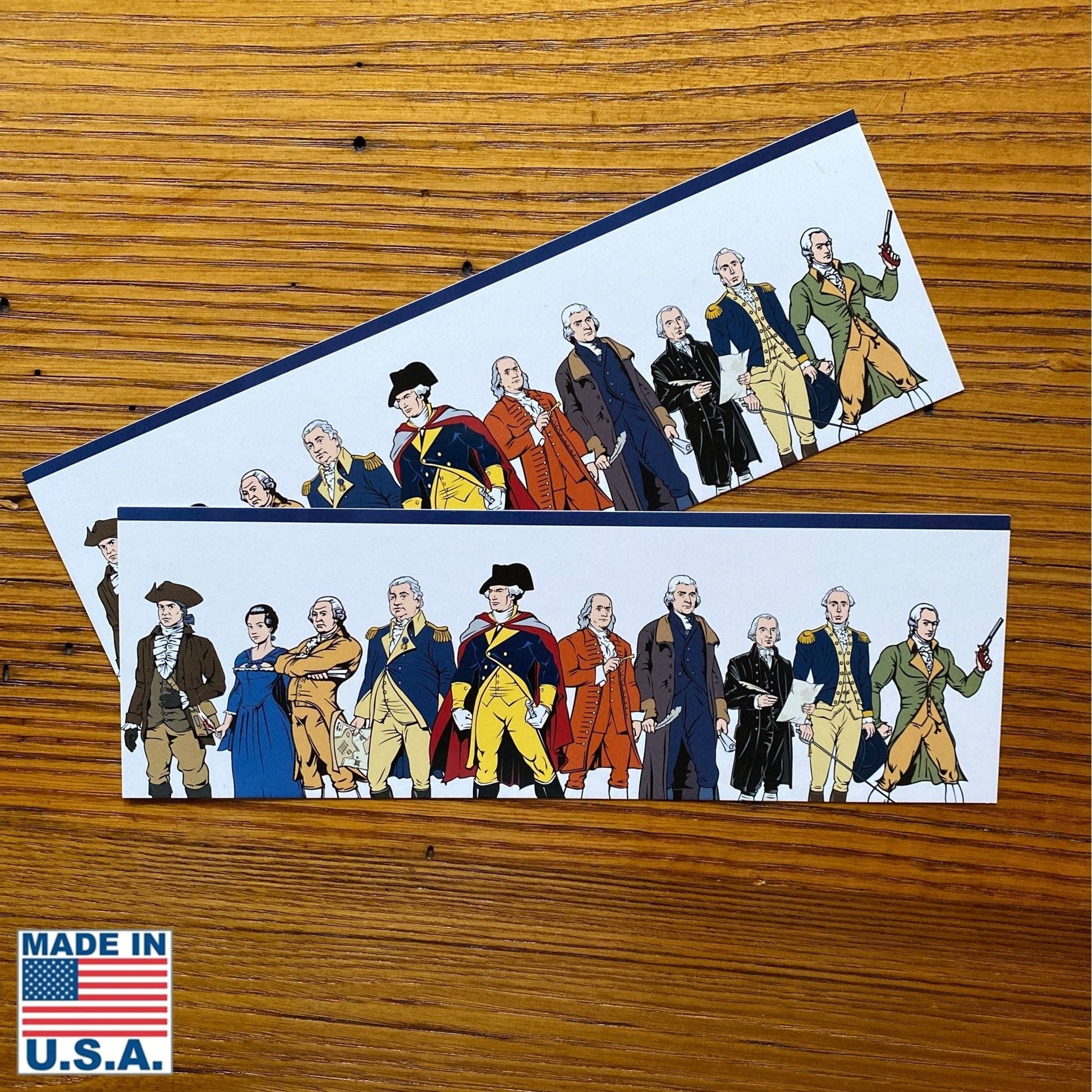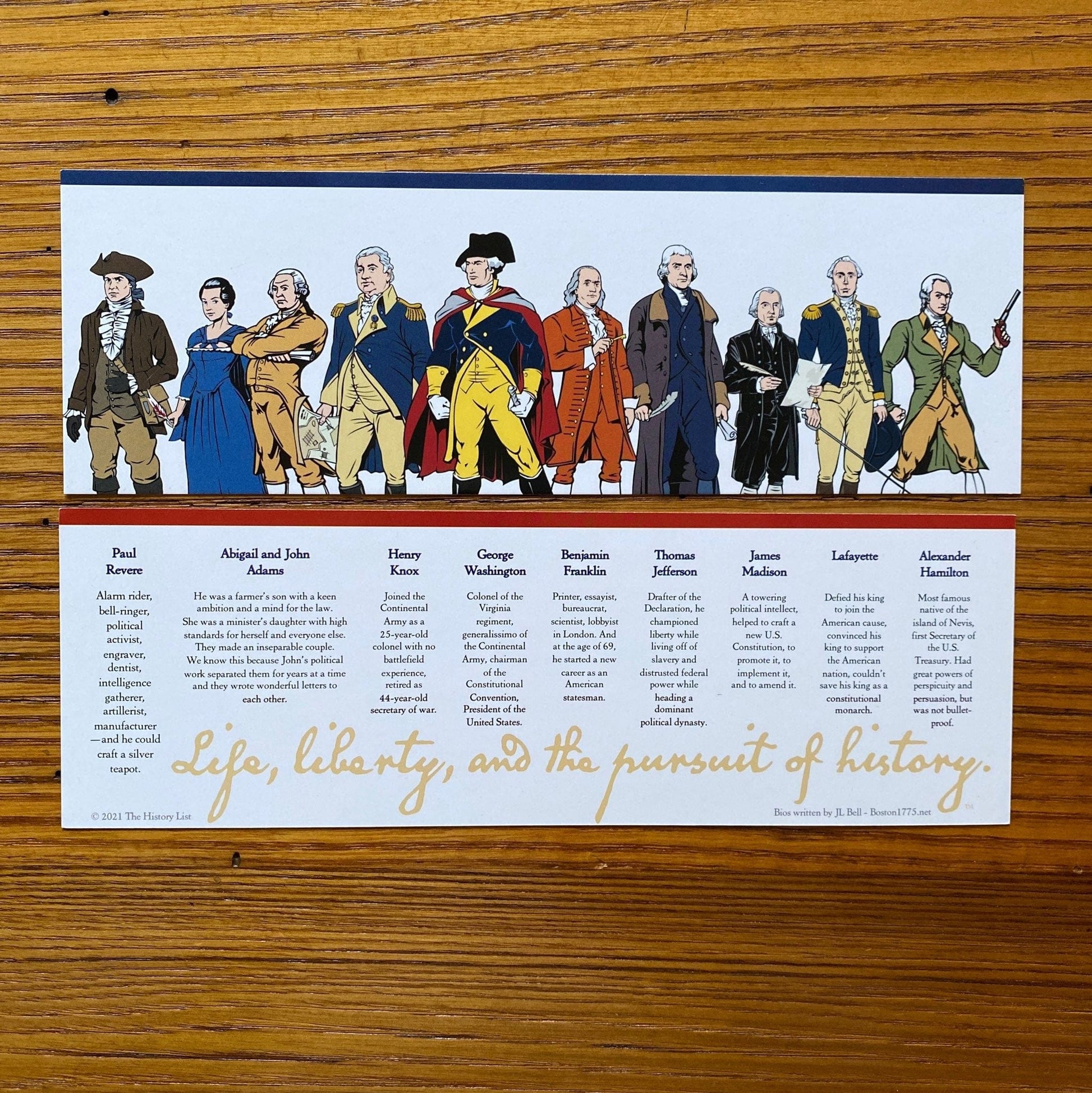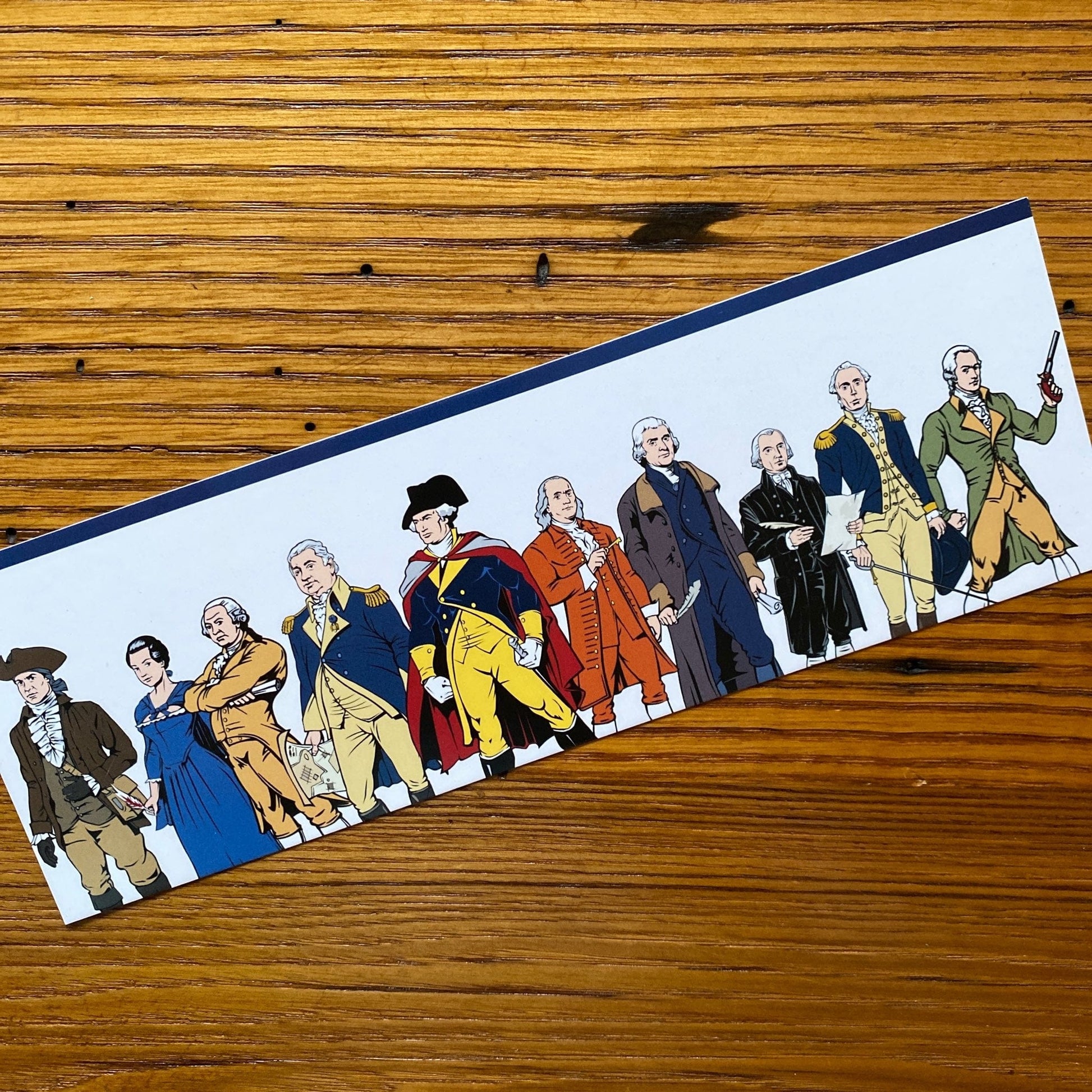The History List
Ten "Revolutionary Superheroes" Bookmark
Ten "Revolutionary Superheroes" Bookmark
Couldn't load pickup availability

Our original design, featuring all ten "Revolutionary Superheroes": Paul Revere, Abigail and John Adams, Henry Knox, George Washington, Ben Franklin, Thomas Jefferson, James Madison, Lafayette, and Alexander Hamilton.
On the back of the bookmark, a short biography on each individual.
Size: 9" x 3"
About the paper weight and printing process: Commercial printing on 10 pt. gloss cardstock.
Also available as a crewneck shirt for men and women, v-neck shirt, pullover sweatshirt, t-shirt in youth sizes, small 14" x 7" poster, magnet, and a sticker.
Explore our complete collection of Revolutionary Superheroes here.
Short Biography on Each Individual
Paul Revere: As an engraver, dispatch rider, and leader of Boston’s craftsmen, Revere was active in the town’s resistance before the Revolutionary War and then served as a state artillery officer.
Trained as a silversmith by his father, an emigrant from France, Paul Revere (1734-1818) applied his metalworking skills to engraving political cartoons during the 1760s and 1770s. He was active in the North End Caucus, which chose candidates for town offices, and joined in patrolling the docks to prevent the East India Company’s tea from being unloaded. Covertly, Revere helped to destroy that tea and organized fellow mechanics to watch British soldiers in 1774. As a messenger, Revere carried news of the tea’s destruction to New York and Philadelphia in December 1773 and a year later warned colleagues in New Hampshire that the Royal Navy might soon take over their harbor fort. Most famously, Revere rode to Lexington on April 18, 1775, to warn of an impending British army march, alerting militia commanders along his route. During the war Revere was an officer in Massachusetts’s artillery regiment. He commanded the unit during the disastrous Penobscot Expedition, afterward demanding a court-martial to clear his name.
Abigail & John Adams An inseparable couple. We know this because John’s political work separated them for years at a time and they wrote wonderful letters to each other.
Henry Knox: Commanded the Continental Army artillery from late 1775 to the end of the war and then worked as the nation’s Secretary of War.
Born in Boston to an Ulster Scot family that fell apart, Henry Knox (1750-1806) secured valuable training as a bookseller. He helped to launch a grenadier company for the town’s militia regiment, his uniform catching the eye of a royal appointee’s daughter, whom he married in 1774. The couple broke with her parents and left Boston after the war began. In July 1775, while helping to lay out a provincial fortification, Knox met the new Continental commander-in-chief, George Washington. By October, Washington was lobbying to put Knox in charge of the army’s artillery regiment. The new colonel’s first assignment was to bring more heavy cannon to the siege lines around Boston. Knox remained close to Washington through the war, seeing action in New York, New Jersey, Pennsylvania, and eventually Virginia. His strength was logistics, as he established artillery training and manufacturing facilities. After the war, the Continental Congress and then President Washington asked Knox to oversee the country’s military, which included responsibilities for coastal forts, militia regulation, and relations with Native nations.
George Washington Colonel of the Virginia regiment, generalissimo of the Continental Army, chairman of the Constitutional Convention, President of the United States.
Benjamin Franklin Printer, essayist, bureaucrat, scientist, lobbyist in London. And at the age of 69, he started a new career as an American statesman.
Thomas Jefferson: Credited primarily with drafting the Declaration of Independence, Jefferson was also a governor, diplomat, secretary of state, and game-changing President.
A Virginia planter and lawyer, Thomas Jefferson (1743-1826) argued for self-government in his 1774 Summary View of the Rights of British America. The next year, Virginia sent him to the Continental Congress. In June 1776 he was placed on the committee to write a declaration of reasons for independence, which John Adams asked him to draft. After debate and changes, Congress approved that document on July 4. Soon afterward Jefferson went home to help write Virginia’s new constitution and law code. He became his state’s governor in 1779, moving its capital from Williamsburg to Richmond, but his second term ended disastrously with an invasion by British forces under Gen. Benedict Arnold. Back in the Congress in 1783, Jefferson’s attempts to work reforms within the Articles of Confederation failed, though he did author the Land Ordinance of 1784. He then went to Paris as a diplomat. Five years later, Jefferson returned to serve as President Washington’s first secretary of state, overseeing not only foreign relations but also patents, the census, and other domestic functions. During those years Jefferson was formulating the principles—a wider franchise for white men, state and local control, opposition to banks—that would define his political party and presidency.
James Madison: Called “Father of the Constitution” for his work shaping that document and the Bill of Rights, Madison worked closely with Washington and then Jefferson to build the new U.S. of A.
Scion of a wealthy Virginia family, James Madison (1751-1836) was 5'4" tall and slight, not cut out for military service. Instead, during the Revolutionary War he served in the Virginia government and at the Continental Congress from 1780 to 1783. Back in Virginia, he pushed Thomas Jefferson’s Statute for Religious Freedom through the legislature. In the 1780s Madison argued for a new Constitution, speaking often at the Philadelphia Convention of 1787 and helping to write the “Federalist” essays. A leader in the first House of Representatives, Madison fulfilled a promise to contingent supporters of the Constitution by introducing amendments to spell out individual rights and limits on the federal power. In the new century he served eight years as Thomas Jefferson’s secretary of state followed by eight years as President.
Lafayette: A wealthy French nobleman, young Lafayette defied his monarch to join the American fight for independence in 1777, becoming one of Gen. Washington’s closest subordinates.
Marie-Joseph Paul Yves Roch Gilbert du Motier (1757-1834) inherited the title of Marquis de la Fayette and a huge fortune before the age of two when his father was killed on the battlefield. He received a commission in the musketeers at thirteen. In 1775 Lafayette learned about the war in America. When the French king forbade him to join that fight, the marquis bought a ship and sailed secretly, reaching Georgetown, South Carolina in June 1777. The Continental Congress was won over by Lafayette’s offer to serve without pay and gave him a major general’s commission but no troops. He impressed Gen. Washington, however, and behaved bravely at Brandywine after being wounded. From then on Lafayette led Continental troops in campaigns all over America. He also traveled back to France in 1779, lobbying the government to send a large army. After participating in the siege of Yorktown, Lafayette returned to France again to maintain its support for the U.S. of A. He also advocated for religious freedom, an end to slavery, and a more republican form of government for France.
Alexander Hamilton Most famous native of the island of Nevis, first Secretary of the U.S. Treasury. Had great powers of perspicuity and persuasion but was not bullet-proof.
Our thanks to J.L. Bell of Boston 1775 for his help on this project and his notes about these Revolutionary Superheroes.
Shipping
Shipping
Flat-rate shipping: Regardless of the number of items you order, the shipping price for shirts, caps, unframed prints and posters, bracelets, lapel pins, pendants, and button packs is $5.95.
For hooded and crewneck sweatshirts, mugs, and blankets, the shipping cost is $8.95.
Our flat rate shipping means you can add two or more t-shirts, sweatshirts, or caps for no additional shipping charge.
Learn more about shipping here.
All original designs are copyrighted by The History List
All original designs are copyrighted by The History List
All designs are copyrighted by The History List and the History Nerd text and design on t-shirts is a registered trademark. If you see a knock off, please let me know.
Made by America
Made by America
Almost all of the new products we offer are designed by us and made in America and most of our Rare Finds were made in America.
Our original designs are based on our nation’s history and our love of American history. Read more about other things we've created, including The History List, History Camp, and The Pursuit of History, in addition to The History List Store.
All original designs are copyrighted by The History List.
Every product that is made in America states that in the product description and includes the "Made in U.S.A." graphic. There are a relatively small number of items where we’ve not been able to find a manufacturing partner here in the States, but we continue to look.
Our nation’s history—Our original designs
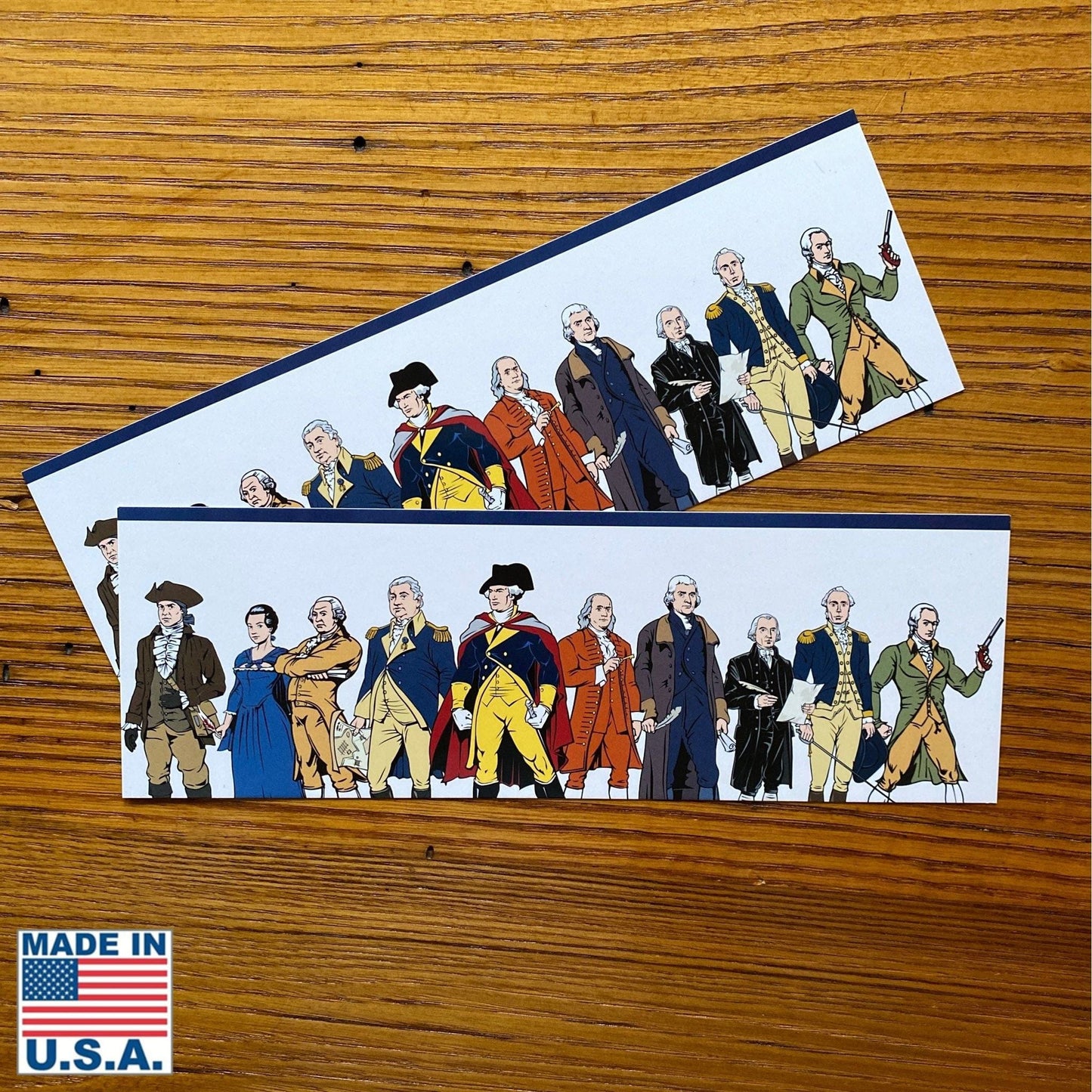
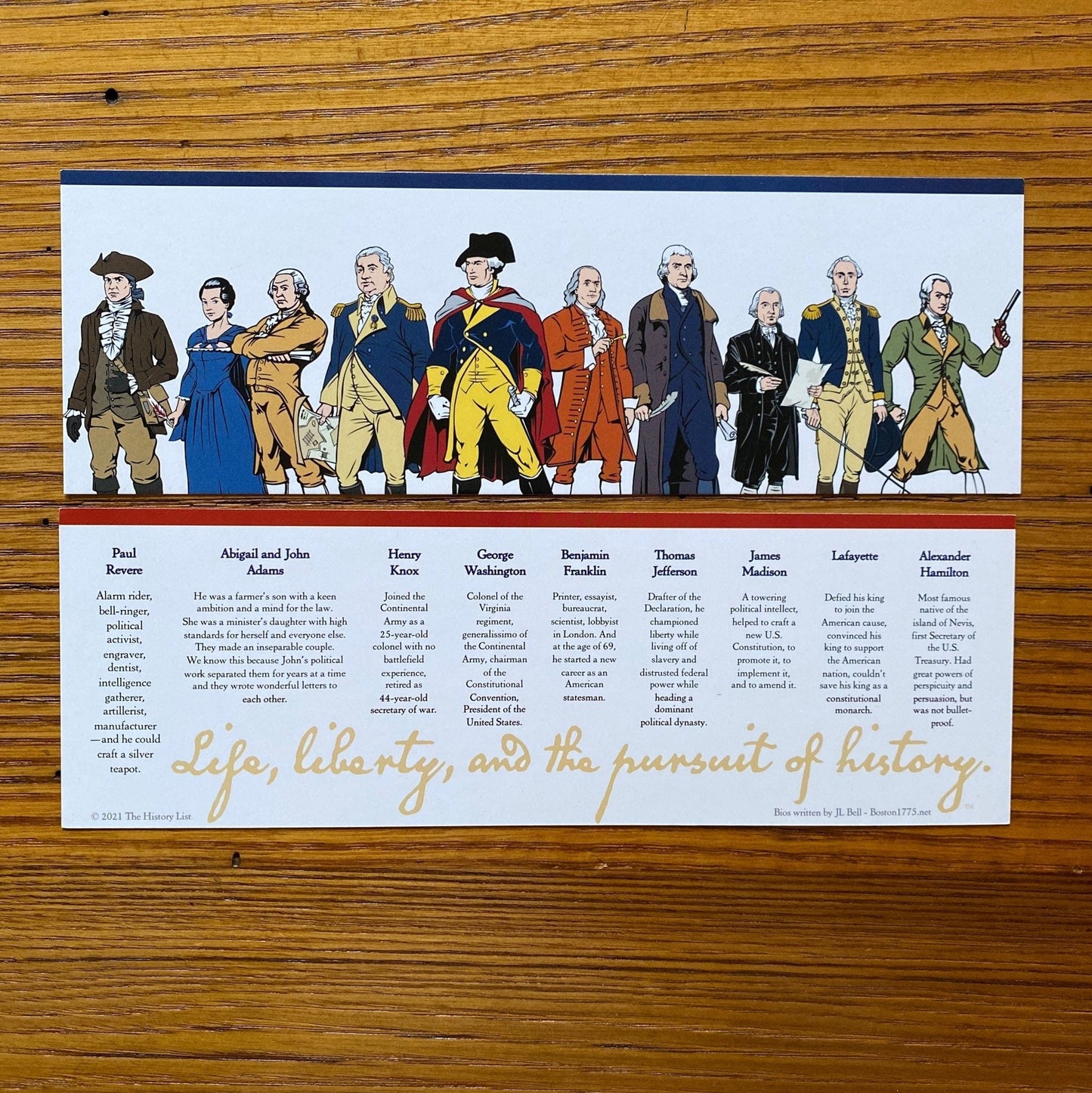
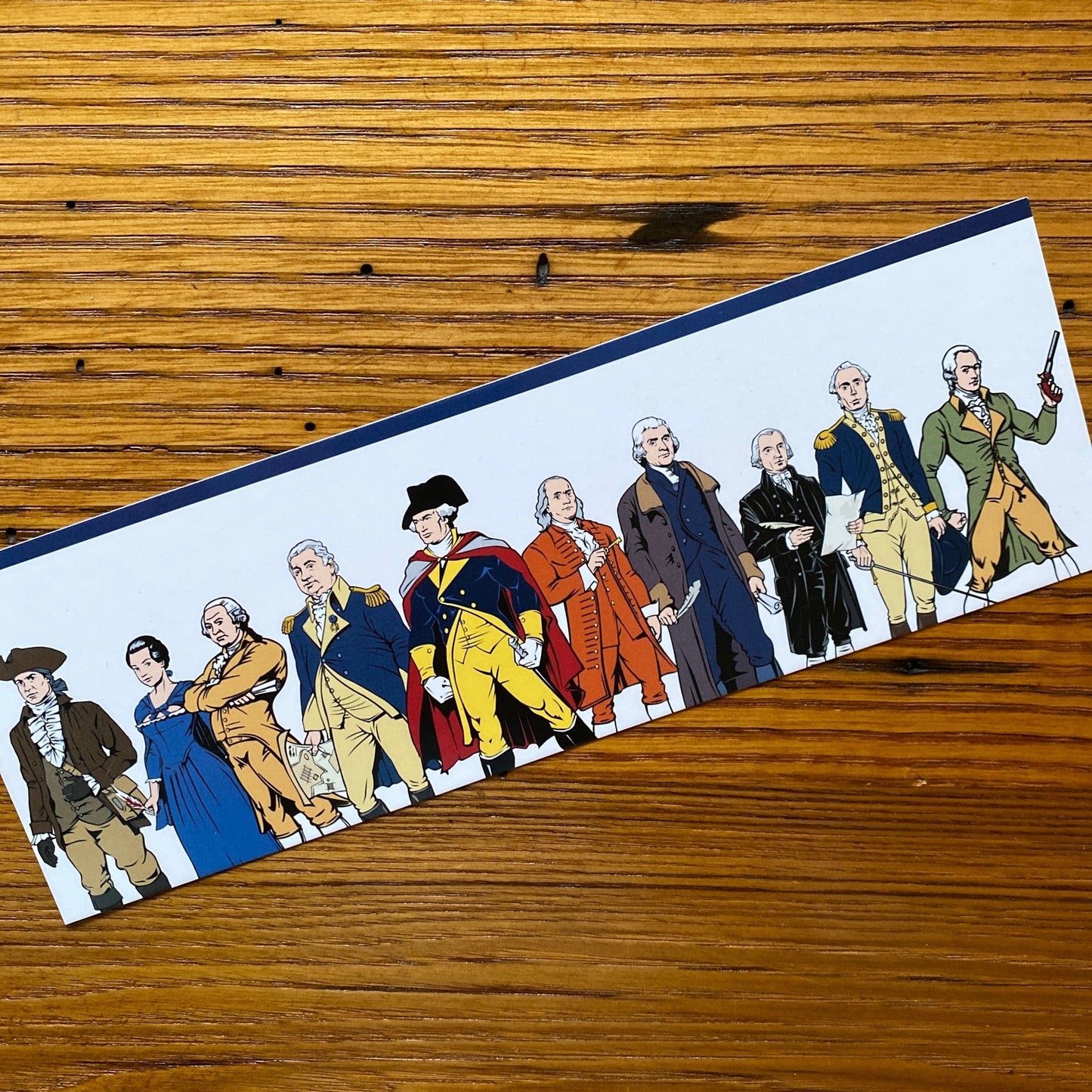
We bought these for an event for our homeschooling group and our kids love them. It’s fun to see them get excited when they see things like this. Enthusiasm is contagious :)
Keep the good ideas coming
Do more of the history cards (not the note cards!)
Excellent product. Craftsmanship is wonderful!

